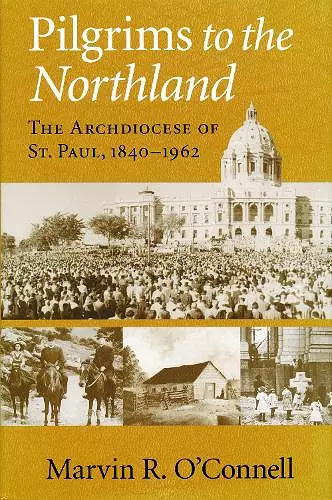Pilgrims to the Northland
The Archdiocese of St. Paul, 1840-1962
Format:Hardback
Publisher:University of Notre Dame Press
Published:15th Feb '09
Currently unavailable, and unfortunately no date known when it will be back

This is the first narrative history of the Archdiocese of St. Paul, from 1840 to 1962. Historian Marvin R. O'Connell brings to life the extraordinary labors and accomplishments of the French priests who came to the upper midwest territory during the first half of the nineteenth century. Over the next fifty years a flood of settlers, primarily Irish and German Catholics, filled up the land. In 1850 Rome created a new diocese centered in the village of St. Paul, and in 1851 French priest Joseph Cretin was named its first bishop.
O'Connell's lively account stresses the social, economic, and political context in which the Catholic Church in Minnesota grew and evolved. He vividly illuminates the personalities of the bishops who followed Cretin, Thomas Grace (1859–84) and John Ireland (1884–1918). Ireland inherited a sophisticated system of churches, schools, orphanages, and hospitals, staffed by orders of religious men and women. Ireland built upon this legacy, founding colleges for men and women, a major seminary, and cathedrals in both St. Paul and Minneapolis. Ireland's successors, Austin Dowling (1919–30) and John Gregory Murray (1931–56) were not as colorful as Ireland, although Murray was immensely popular. William Brady is the final archbishop covered in this book, serving from 1956 to 1961 when he died unexpectedly from a heart attack. O'Connell ends his narrative in 1962, soon after the death of Archbishop Brady and a few months before the first session of Vatican II.
"Marvin R. O Connell's sweeping Pilgrims to the Northland makes a strong case for the persistence of diocesan-level histories of U.S. Catholicism . . . . O'Connell demonstrates that what is now the Archdiocese of St. Paul and Minneapolis has been not just a chilly northern outpost of immigrant Catholicism, but an important stomping ground for many of the American Church's most important figures . . . . [R]eaders could not do any better than a narrator like Father O' Connell—a Minnesota native and a history professor emeritus at Notre Dame. He has crafted an eminently readable tome, one that already begs for a sequel." —The Journal of Religion
"O'Connell can always be counted on for a well-researched and well-written text—and this volume does not disappoint. What is truly delightful about this text is O'Connell's artistry with words—which he uses to breathe life and color into this history. O'Connell also deftly employs his own recollections of people, places, and events in the Archdiocese of St. Paul from the 1940s onward." —American Catholic Studies
"This massive narrative escapes the status of mere chronicle through its spirited style, its perceptive appraisal of its cast of (frequently Episcopal) characters, and its sense of the rootedness of ecclesiastical in social history." —Church History
". . . the volume illustrates the pivotal role of the Archdiocese of St. Paul regarding liturgy, social justice, and an ecclesiology at home in America. O'Connell's solid research, written in fascinating style and integrated into a larger vision, is a valuable addition to the study of Catholicism in Minnesota and beyond." —Theological Studies
"In twenty-four splendidly written and researched chapters, the reader gains an appreciation for the human dimensions significant to the developing archdiocese of St. Paul and Minneapolis, not just an annotated biography of bishops and archbishops. . . . This captivating study of pioneer Catholicism also speaks with relevance to contemporary times, especially in areas of immigration, education, healthcare, social welfare and social change." —Catholic Library World
" . . . Father O'Connell tells the history of the Archdiocese of St. Paul, emphasizing the social, economic, and political context in which the Catholic Church in Minnesota evolved. It begins with the labors and accomplishments o the French priests who arrived during the first half of the 19th century and continues through the death of Archbishop William Brady in 1961." —The Catholic Spirit
" . . . historian Marvin R. O'Connell offers a detailed and engaging narrative of the institution that was integral to Catholicism in the Upper Midwest in the years before Vatican II. This big book is rich in stories of personalities, faith, struggle, and triumph." —Minnesota History
"What a gallery of memorable characters we find among these 'Pilgrims to the Northland.' And what a fabulous job Marvin O'Connell has done in telling their stories! Besides a major work of scholarship, he has given us what is surely the most readable diocesan history ever written." —Philip Gleason, University of Notre Dame
"With a sweeping overview, cogent detail, and witty insight, Marvin O'Connell tells the stories of the people who built the Archdiocese of St. Paul: men of energy, grace, vision, and not a little political skill; scoundrels and scalawags on a fluid frontier; women religious who made possible the schools and hospitals that nurtured the faithful; families who built churches through deep faith and painful sacrifice. We see these real people, with personalities and passions and flaws, leaving enduring marks on Minnesota's landscape. This is a grand tale on a grand scale." —Ann Regan, author of Irish in Minnesota
ISBN: 9780268037291
Dimensions: 229mm x 152mm x 43mm
Weight: 1175g
688 pages